Nanpeng Yu
Generating Synthetic Net Load Data with Physics-informed Diffusion Model
Jun 04, 2024Abstract:This paper presents a novel physics-informed diffusion model for generating synthetic net load data, addressing the challenges of data scarcity and privacy concerns. The proposed framework embeds physical models within denoising networks, offering a versatile approach that can be readily generalized to unforeseen scenarios. A conditional denoising neural network is designed to jointly train the parameters of the transition kernel of the diffusion model and the parameters of the physics-informed function. Utilizing the real-world smart meter data from Pecan Street, we validate the proposed method and conduct a thorough numerical study comparing its performance with state-of-the-art generative models, including generative adversarial networks, variational autoencoders, normalizing flows, and a well calibrated baseline diffusion model. A comprehensive set of evaluation metrics is used to assess the accuracy and diversity of the generated synthetic net load data. The numerical study results demonstrate that the proposed physics-informed diffusion model outperforms state-of-the-art models across all quantitative metrics, yielding at least 20% improvement.
Solve Large-scale Unit Commitment Problems by Physics-informed Graph Learning
Nov 26, 2023
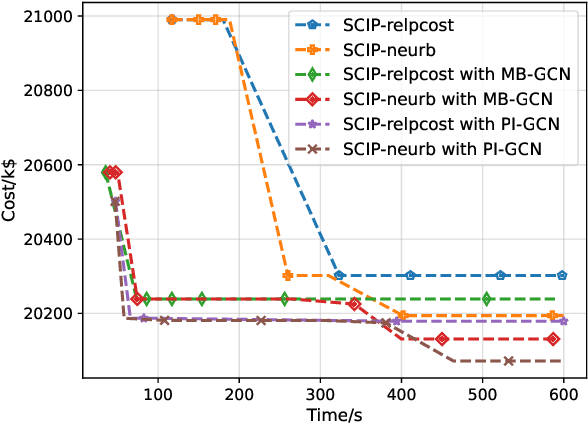
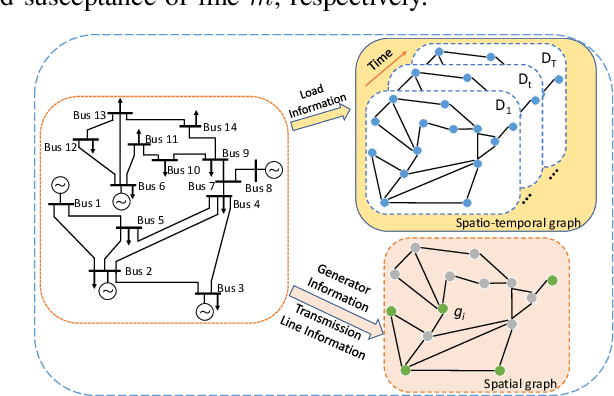
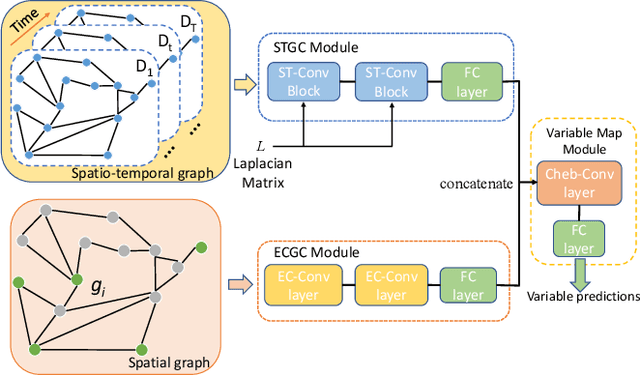
Abstract:Unit commitment (UC) problems are typically formulated as mixed-integer programs (MIP) and solved by the branch-and-bound (B&B) scheme. The recent advances in graph neural networks (GNN) enable it to enhance the B&B algorithm in modern MIP solvers by learning to dive and branch. Existing GNN models that tackle MIP problems are mostly constructed from mathematical formulation, which is computationally expensive when dealing with large-scale UC problems. In this paper, we propose a physics-informed hierarchical graph convolutional network (PI-GCN) for neural diving that leverages the underlying features of various components of power systems to find high-quality variable assignments. Furthermore, we adopt the MIP model-based graph convolutional network (MB-GCN) for neural branching to select the optimal variables for branching at each node of the B&B tree. Finally, we integrate neural diving and neural branching into a modern MIP solver to establish a novel neural MIP solver designed for large-scale UC problems. Numeral studies show that PI-GCN has better performance and scalability than the baseline MB-GCN on neural diving. Moreover, the neural MIP solver yields the lowest operational cost and outperforms a modern MIP solver for all testing days after combining it with our proposed neural diving model and the baseline neural branching model.
Adversarial Purification for Data-Driven Power System Event Classifiers with Diffusion Models
Nov 13, 2023Abstract:The global deployment of the phasor measurement units (PMUs) enables real-time monitoring of the power system, which has stimulated considerable research into machine learning-based models for event detection and classification. However, recent studies reveal that machine learning-based methods are vulnerable to adversarial attacks, which can fool the event classifiers by adding small perturbations to the raw PMU data. To mitigate the threats posed by adversarial attacks, research on defense strategies is urgently needed. This paper proposes an effective adversarial purification method based on the diffusion model to counter adversarial attacks on the machine learning-based power system event classifier. The proposed method includes two steps: injecting noise into the PMU data; and utilizing a pre-trained neural network to eliminate the added noise while simultaneously removing perturbations introduced by the adversarial attacks. The proposed adversarial purification method significantly increases the accuracy of the event classifier under adversarial attacks while satisfying the requirements of real-time operations. In addition, the theoretical analysis reveals that the proposed diffusion model-based adversarial purification method decreases the distance between the original and compromised PMU data, which reduces the impacts of adversarial attacks. The empirical results on a large-scale real-world PMU dataset validate the effectiveness and computational efficiency of the proposed adversarial purification method.
pmuBAGE: The Benchmarking Assortment of Generated PMU Data for Power System Events
Oct 25, 2022Abstract:This paper introduces pmuGE (phasor measurement unit Generator of Events), one of the first data-driven generative model for power system event data. We have trained this model on thousands of actual events and created a dataset denoted pmuBAGE (the Benchmarking Assortment of Generated PMU Events). The dataset consists of almost 1000 instances of labeled event data to encourage benchmark evaluations on phasor measurement unit (PMU) data analytics. PMU data are challenging to obtain, especially those covering event periods. Nevertheless, power system problems have recently seen phenomenal advancements via data-driven machine learning solutions. A highly accessible standard benchmarking dataset would enable a drastic acceleration of the development of successful machine learning techniques in this field. We propose a novel learning method based on the Event Participation Decomposition of Power System Events, which makes it possible to learn a generative model of PMU data during system anomalies. The model can create highly realistic event data without compromising the differential privacy of the PMUs used to train it. The dataset is available online for any researcher or practitioner to use at the pmuBAGE Github Repository: https://github.com/NanpengYu/pmuBAGE.
An Optimization Method-Assisted Ensemble Deep Reinforcement Learning Algorithm to Solve Unit Commitment Problems
Jun 09, 2022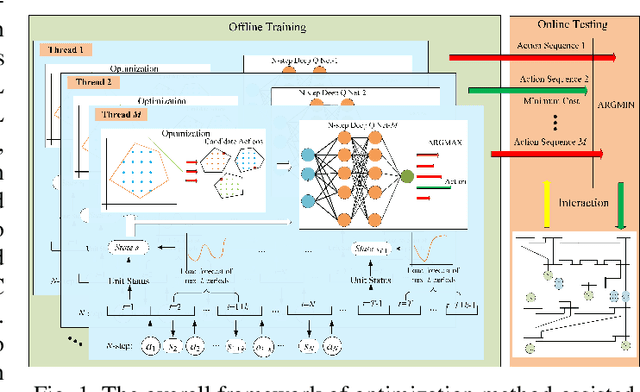
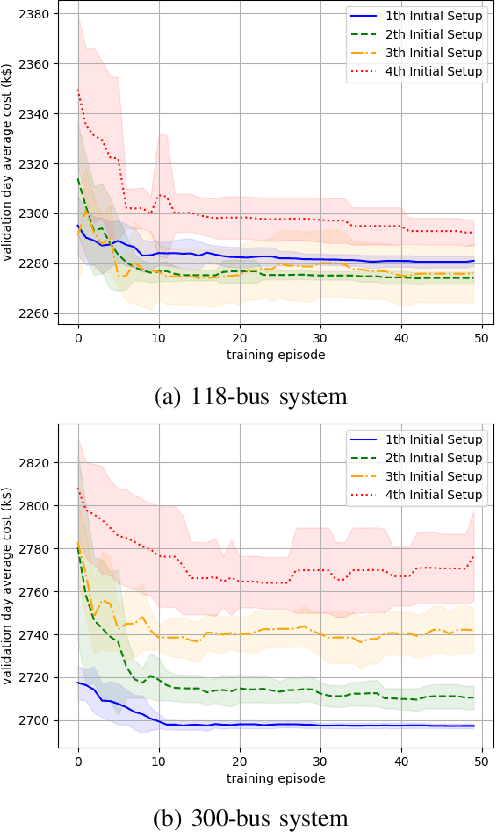

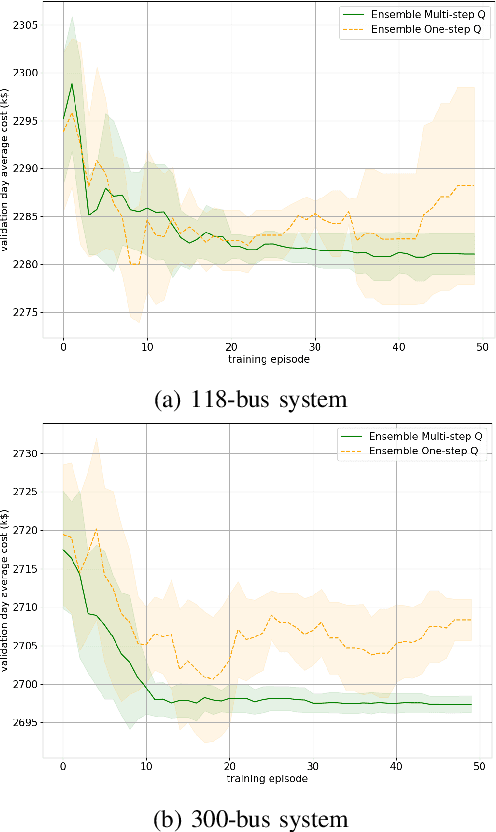
Abstract:Unit commitment (UC) is a fundamental problem in the day-ahead electricity market, and it is critical to solve UC problems efficiently. Mathematical optimization techniques like dynamic programming, Lagrangian relaxation, and mixed-integer quadratic programming (MIQP) are commonly adopted for UC problems. However, the calculation time of these methods increases at an exponential rate with the amount of generators and energy resources, which is still the main bottleneck in industry. Recent advances in artificial intelligence have demonstrated the capability of reinforcement learning (RL) to solve UC problems. Unfortunately, the existing research on solving UC problems with RL suffers from the curse of dimensionality when the size of UC problems grows. To deal with these problems, we propose an optimization method-assisted ensemble deep reinforcement learning algorithm, where UC problems are formulated as a Markov Decision Process (MDP) and solved by multi-step deep Q-learning in an ensemble framework. The proposed algorithm establishes a candidate action set by solving tailored optimization problems to ensure a relatively high performance and the satisfaction of operational constraints. Numerical studies on IEEE 118 and 300-bus systems show that our algorithm outperforms the baseline RL algorithm and MIQP. Furthermore, the proposed algorithm shows strong generalization capacity under unforeseen operational conditions.
A Reinforcement Learning-based Volt-VAR Control Dataset and Testing Environment
Apr 20, 2022



Abstract:To facilitate the development of reinforcement learning (RL) based power distribution system Volt-VAR control (VVC), this paper introduces a suite of open-source datasets for RL-based VVC algorithm research that is sample efficient, safe, and robust. The dataset consists of two components: 1. a Gym-like VVC testing environment for the IEEE-13, 123, and 8500-bus test feeders and 2. a historical operational dataset for each of the feeders. Potential users of the dataset and testing environment could first train an sample-efficient off-line (batch) RL algorithm on the historical dataset and then evaluate the performance of the trained RL agent on the testing environments. This dataset serves as a useful testbed to conduct RL-based VVC research mimicking the real-world operational challenges faced by electric utilities. Meanwhile, it allows researchers to conduct fair performance comparisons between different algorithms.
pmuBAGE: The Benchmarking Assortment of Generated PMU Data for Power System Events -- Part I: Overview and Results
Apr 03, 2022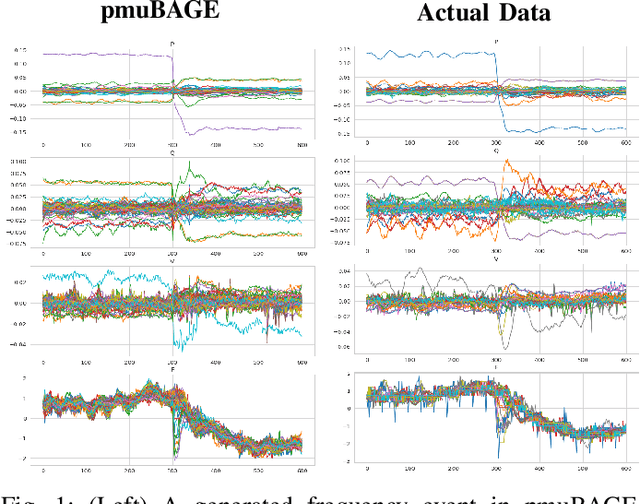

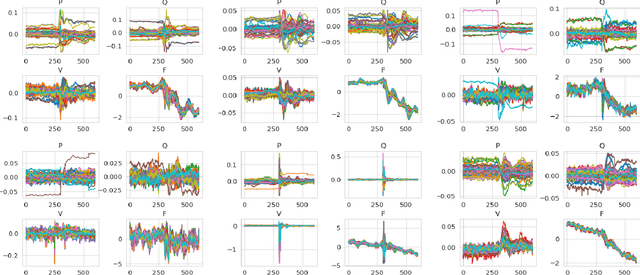
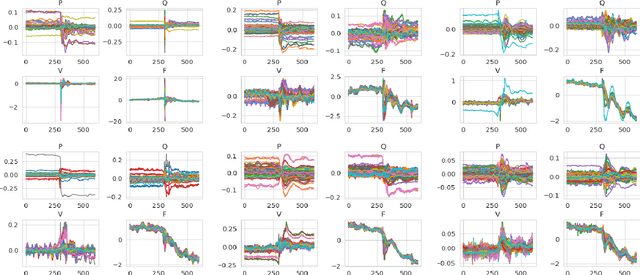
Abstract:We present pmuGE (phasor measurement unit Generator of Events), one of the first data-driven generative model for power system event data. We have trained this model on thousands of actual events and created a dataset denoted pmuBAGE (the Benchmarking Assortment of Generated PMU Events). The dataset consists of almost 1000 instances of labeled event data to encourage benchmark evaluations on phasor measurement unit (PMU) data analytics. The dataset is available online for use by any researcher or practitioner in the field. PMU data are challenging to obtain, especially those covering event periods. Nevertheless, power system problems have recently seen phenomenal advancements via data-driven machine learning solutions - solutions created by researchers who were fortunate enough to obtain such PMU data. A highly accessible standard benchmarking dataset would enable a drastic acceleration of the development of successful machine learning techniques in this field. We propose a novel learning method based on the Event Participation Decomposition of Power System Events, which makes it possible to learn a generative model of PMU data during system anomalies. The model can create highly realistic event data without compromising the differential privacy of the PMUs used to train it. The dataset is available online for any researcher to use at the pmuBAGE Github Repository - https://github.com/NanpengYu/pmuBAGE. Part I - This is part I of a two part paper. In part I, we describe a high level overview of pmuBAGE, its creation, and the experiments used to test it. Part II will discuss the exact models used in its generation in far more detail.
Learning to Operate an Electric Vehicle Charging Station Considering Vehicle-grid Integration
Nov 01, 2021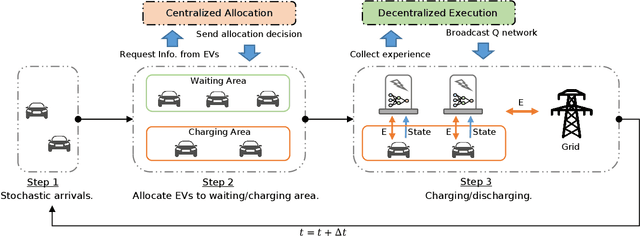
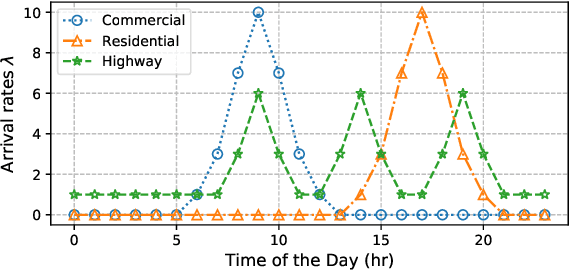
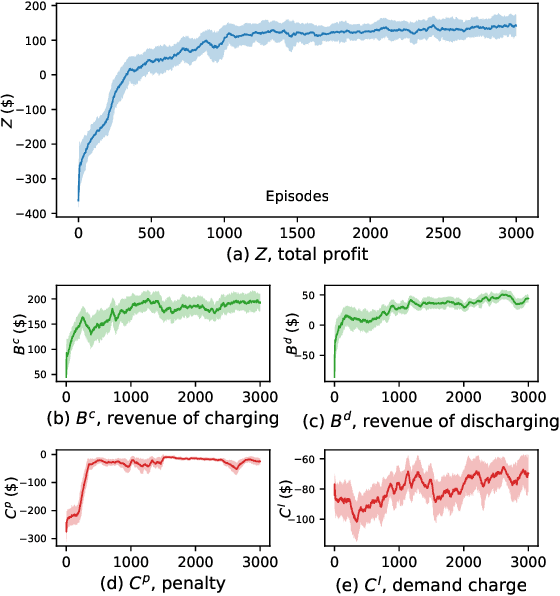
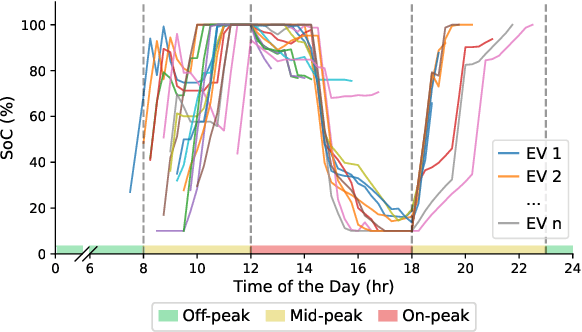
Abstract:The rapid adoption of electric vehicles (EVs) calls for the widespread installation of EV charging stations. To maximize the profitability of charging stations, intelligent controllers that provide both charging and electric grid services are in great need. However, it is challenging to determine the optimal charging schedule due to the uncertain arrival time and charging demands of EVs. In this paper, we propose a novel centralized allocation and decentralized execution (CADE) reinforcement learning (RL) framework to maximize the charging station's profit. In the centralized allocation process, EVs are allocated to either the waiting or charging spots. In the decentralized execution process, each charger makes its own charging/discharging decision while learning the action-value functions from a shared replay memory. This CADE framework significantly improves the scalability and sample efficiency of the RL algorithm. Numerical results show that the proposed CADE framework is both computationally efficient and scalable, and significantly outperforms the baseline model predictive control (MPC). We also provide an in-depth analysis of the learned action-value function to explain the inner working of the reinforcement learning agent.
Machine Learning-Driven Virtual Bidding with Electricity Market Efficiency Analysis
Apr 06, 2021



Abstract:This paper develops a machine learning-driven portfolio optimization framework for virtual bidding in electricity markets considering both risk constraint and price sensitivity. The algorithmic trading strategy is developed from the perspective of a proprietary trading firm to maximize profit. A recurrent neural network-based Locational Marginal Price (LMP) spread forecast model is developed by leveraging the inter-hour dependencies of the market clearing algorithm. The LMP spread sensitivity with respect to net virtual bids is modeled as a monotonic function with the proposed constrained gradient boosting tree. We leverage the proposed algorithmic virtual bid trading strategy to evaluate both the profitability of the virtual bid portfolio and the efficiency of U.S. wholesale electricity markets. The comprehensive empirical analysis on PJM, ISO-NE, and CAISO indicates that the proposed virtual bid portfolio optimization strategy considering the price sensitivity explicitly outperforms the one that neglects the price sensitivity. The Sharpe ratio of virtual bid portfolios for all three electricity markets are much higher than that of the S&P 500 index. It was also shown that the efficiency of CAISO's two-settlement system is lower than that of PJM and ISO-NE.
Estimate Three-Phase Distribution Line Parameters With Physics-Informed Graphical Learning Method
Feb 17, 2021



Abstract:Accurate estimates of network parameters are essential for modeling, monitoring, and control in power distribution systems. In this paper, we develop a physics-informed graphical learning algorithm to estimate network parameters of three-phase power distribution systems. Our proposed algorithm uses only readily available smart meter data to estimate the three-phase series resistance and reactance of the primary distribution line segments. We first develop a parametric physics-based model to replace the black-box deep neural networks in the conventional graphical neural network (GNN). Then we derive the gradient of the loss function with respect to the network parameters and use stochastic gradient descent (SGD) to estimate the physical parameters. Prior knowledge of network parameters is also considered to further improve the accuracy of estimation. Comprehensive numerical study results show that our proposed algorithm yields high accuracy and outperforms existing methods.
 Add to Chrome
Add to Chrome Add to Firefox
Add to Firefox Add to Edge
Add to Edge